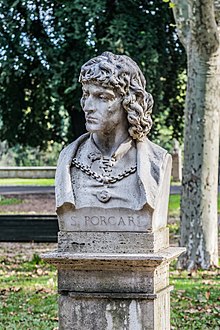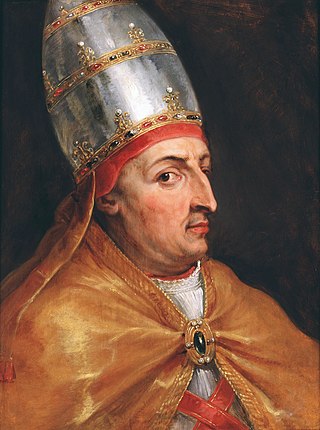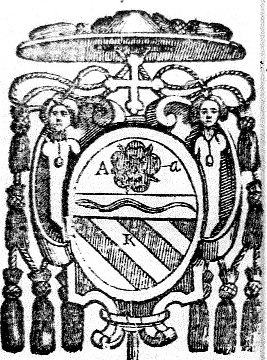
Stefano Porcari (1391 [1] - 9 January 1453) was an Italian politician and humanist from Rome, known as the leader of a rebellion against Pope Nicholas V and the Papal secular authority in Rome. [2]

Stefano Porcari (1391 [1] - 9 January 1453) was an Italian politician and humanist from Rome, known as the leader of a rebellion against Pope Nicholas V and the Papal secular authority in Rome. [2]

Porcari was born into a wealthy family of Rome. He received a humanist education and became an admirer of the ancient Roman Republic. Porcari trained as a lawyer, and in 1427 and 1428 was elected capitano del popolo of Florence under the protection of Pope Martin V. There he met the humanist scholar Leonardo Bruni and the Camaldolese monk Ambrose Traversari. While in Florence, it was Porcari's habit, during public celebrations, to give speeches from a balcony on the Palazzo della Signoria, exhorting the people to honor justice, as the foundation of the commune. He then traveled to France and Germany. [3]
After his return to Italy in 1430, he held several positions in Italian communes such as the podestà of Bologna (1432), Siena (1434), Orvieto (1435) and was also governor of the fortress of Trani. He came back to Rome under the rule of Pope Eugenius IV. When the latter died and before the new pope was elected, he repeatedly addressed the populace to overthrow the papal rule, and to replace them by one based on the ancient Roman republic.
The new pope, Nicholas V, pardoned him, [4] but kept him away from Rome with several assignments.
However, his participation in other plots (including one connected with the crowning of Frederick III in Rome), and an inflammatory speech in the Piazza Navona against the government, led the pope to exile him to Bologna. Roberto Cessi suggests that if this was taken as anything more than a criticism of the local city administrators, he would have been dealt with more harshly. [5]
In late December 1452 Porcari was able to escape and return to Rome. Here he organized an insurrection whose result would be the proclamation of the Republic and, for Porcari, the title of tribune, the same held by Cola di Rienzo in the 14th century. The action was set for the Feast of the Epiphany, 6 January 1453, and would be backed by some three hundred mercenaries. [3] George of Trebizond claimed to have become aware of the conspiracy, through a disaffected priest, nearly a year before and attempted to warn Pope Nicholas. [6]
Nicholas V, warned by Cardinal Basilios Bessarion that Porcari had disappeared, ordered investigations. Porcari had planned to arrest Nicholas at Old St. Peter's Basilica and kill members of the curia. Among the co-conspirators were Stefano Infessura and members of the Orsini. The conspirators were captured, including Porcari, who had tried to take shelter in the house of prince Latino Orsini. He was subsequently tried and hanged at Castel Sant'Angelo on 9 January 1453. [7]
Of Porcari's literary works, sixteen concioni (discourses) have survived. The description of his revolt was provided by Leon Battista Alberti in the epistle De porcario coniuratione.

The House of Orsini is an Italian noble family that was one of the most influential princely families in medieval Italy and Renaissance Rome. Members of the Orsini family include five popes: Stephen II (752–757), Paul I (757–767), Celestine III (1191–1198), Nicholas III (1277–1280), and Benedict XIII (1724–1730). In addition, the family included 34 cardinals, numerous condottieri, and other significant political and religious figures.

Pope Sixtus IV was head of the Catholic Church and ruler of the Papal States from 9 August 1471 to his death, in August 1484. His accomplishments as pope included the construction of the Sistine Chapel and the creation of the Vatican Library. A patron of the arts, he brought together the group of artists who ushered the Early Renaissance into Rome with the first masterpieces of the city's new artistic age.

Pope Nicholas V, born Tommaso Parentucelli, was head of the Catholic Church and ruler of the Papal States from 6 March 1447 until his death, in March 1455. Pope Eugene IV made him a cardinal in 1446 after successful trips to Italy and Germany, and when Eugene died the next year, Parentucelli was elected in his place. He took his name Nicholas in memory of his obligations to Niccolò Albergati.

Bessarion was a Byzantine Greek Renaissance humanist, theologian, Catholic cardinal and one of the famed Greek scholars who contributed to the so-called great revival of letters in the 15th century.

The Republic of Florence, known officially as the Florentine Republic, was a medieval and early modern state that was centered on the Italian city of Florence in Tuscany, Italy. The republic originated in 1115, when the Florentine people rebelled against the Margraviate of Tuscany upon the death of Matilda of Tuscany, who controlled vast territories that included Florence. The Florentines formed a commune in her successors' place. The republic was ruled by a council known as the Signoria of Florence. The signoria was chosen by the gonfaloniere, who was elected every two months by Florentine guild members.
Stefano Infessura was an Italian humanist historian and lawyer. He is remembered through his municipalist Diary of the City of Rome, a partisan chronicle of events at Rome by the Colonna family's point of view. He was in a position to hear everything that circulated in informed Roman circles, for he was the longtime secretary of the Roman Senate. Anecdotes that Infessura relates may be colored by his own partisan nature, but his diary faithfully records news that was making the rounds in the city, whether true or not; "he inserted every fragment of the most preposterous and malevolent gossip current in Roman society, and is therefore not considered a reliable chronicler".

The Pazzi conspiracy was a failed plot by members of the Pazzi family and others to displace the Medici family as rulers of Renaissance Florence.
The War of Ferrara was fought in 1482–1484 between Ercole I d'Este, Duke of Ferrara, and the Papal forces mustered by Ercole's personal nemesis, Pope Sixtus IV and his Venetian allies. Hostilities ended with the Treaty of Bagnolo, signed on 7 August 1484.

Raffaele MaffeiOSM was an Italian humanist, historian and theologian; and member of the Servite Order. He was a native of Volterra, Italy, and therefore is called Raphael Volaterranus or Raphael of Volterra; also Maffeus Volaterranus, or Raffaele Volterrano. Raffaele Maffei wrote the Commentaria Urbana, which was an encyclopedia divided into three parts.
Giordano Orsini was an Italian cardinal who enjoyed an extensive career in the early fifteenth century. He was a member of the powerful Roman family of the Orsini.

Niccolò Perotti, also Perotto or Nicolaus Perottus was an Italian humanist and the author of one of the first modern Latin school grammars.
Tiburzio di Maso was a leader of an anarchic faction in Rome that briefly attempted to restore the medieval commune of the city, the last attempt at populist government in the States of the Church.

Giacomo or Jacopo d'Angelo, better known by his Latin name Jacobus Angelus, was an Italian classical scholar, humanist, and translator of ancient Greek texts during the Renaissance. Named for the village of Scarperia in the Mugello in the Republic of Florence, he traveled to Venice where the Byzantine emperor Manuel II Palaiologos' ambassador Manuel Chrysoloras was teaching Greek, the first scholar to hold such course in medieval Italy.

Napoleone Orsini was a Roman cardinal. His ecclesiastical career lasted 57 years, 54 of them as a cardinal, and included six conclaves.
Prospero Colonna was a cardinal-nephew of Pope Martin V, whose election ended the Western Schism. Colonna was excommunicated for a period due to his rebellion against Martin V's successor, Pope Eugene IV, becoming one of the few excommunicated cardinals. Despite this, Colonna was the leading candidate to succeed Eugene IV in the papal conclave, 1447, where he was two votes away from election for the first three days.
Giovanni Gaetano Orsini, Cardinal of the Holy Roman Church from 17 December 1316 until his death, was a Roman nobleman, a nephew of Pope Nicholas III and a grandson of Matteo Rosso Orsini.

Giambattista Orsini was an Italian Roman Catholic cardinal. He served as papal legate to the Marches of Ancona.

Gentile de' Becchi was an Italian bishop, diplomat, orator and writer. He was a member of the Platonic Academy of the Medici of Florence and tutor of Lorenzo the Magnificent and his son Giovanni de' Medici, later Pope Leo X. Of his writings there exist many letters, poems in Latin, and prayers which are praised by historian Cecil Grayson as his finest works.

Niccolò Bonafede was a Roman Catholic prelate who served as Bishop of Chiusi (1504–1533).
Paolo Orsini was an Italian condottiero in the service of the Papal States, Ferdinand of Aragon and the Republic of Florence. He was marquess of Atripalda and lord of Mentana, Palombara Sabina and Selci.